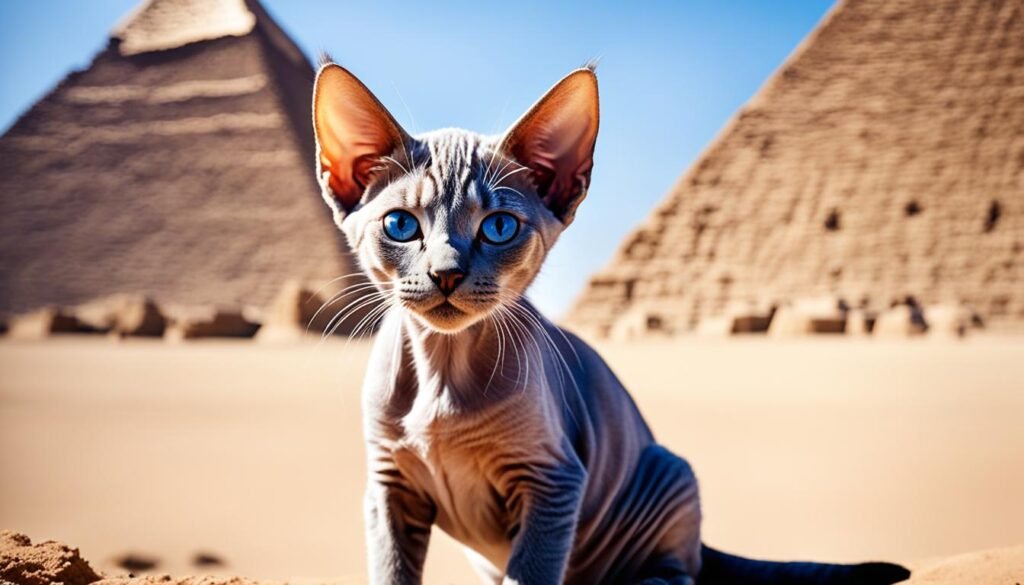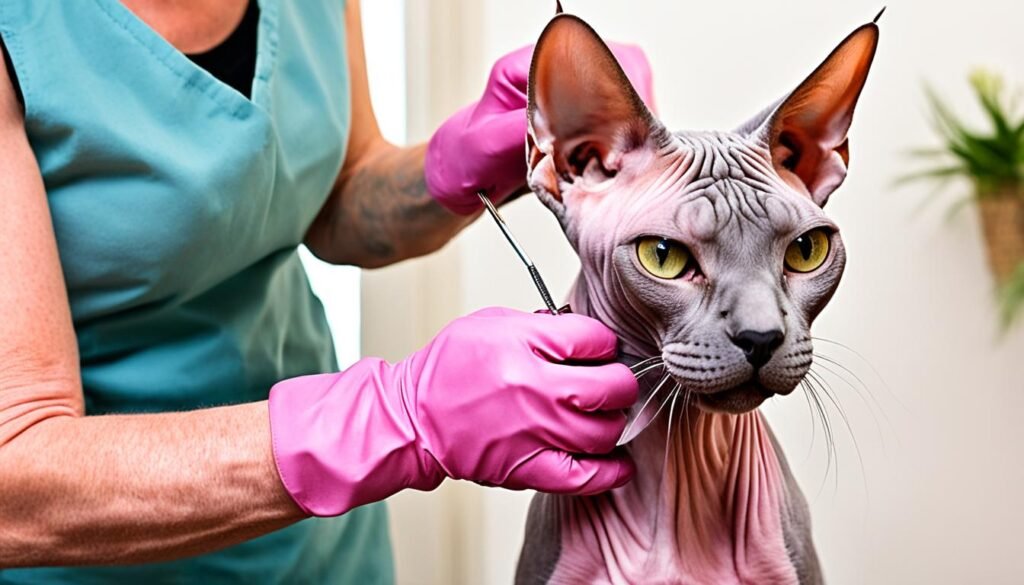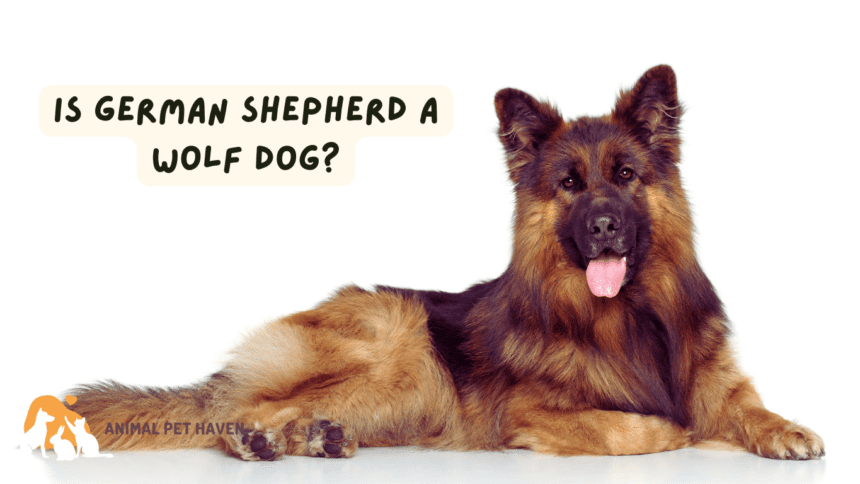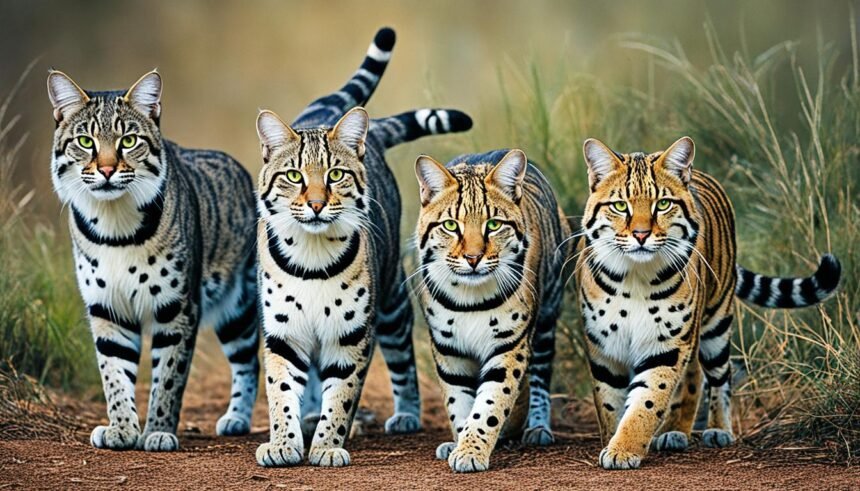Many people wonder if Sphynx cats come from Egypt because of their special look. These cats are known for their lack of hair and mystery. They remind us of the famous sphinx statues in Egypt. Yet, their story is more than just that. Are sphynx cats from Egypt? Discover the intriguing history of Sphynx cats. Despite their name and appearance, Sphynx cats are not originally from Egypt. Learn about their true origins and unique characteristics.
The Sphynx breed stands out from other hairless cats like the Russian Peterbald. Its story starts in the 1960s with a kitten named Prune in Toronto, Canada. This unique kitten caught the eye of breeders.
Breeders started a journey to create a new kind of cat. They carefully picked cats from different places to join the Sphynx family. Thanks to their hard work, the Sphynx became known for its special look. It’s because of them that we have these unique and loved cats today.
The Enigmatic Charm of Sphynx Cats
Sphynx cats are loved worldwide for their unique, hairless look and charming ways. They have an interesting history, linked with ancient Egypt because they look like the Great Sphinx of Giza. Even though the breed began in Canada, their distinct features have made them popular pets for cat lovers everywhere.
Striking Hairless Appearance
Sphynx cats stand out because they have no fur. Their skin is soft like suede or chamois leather. They either have a very thin layer of fuzz or are completely hairless. But they do have whiskers, which are sometimes short or broken. They also have a unique face shape, big ears, and a strong build.
What’s really interesting is that their skin can have different colors, patterns, and feels. This makes them even more visually intriguing.
Captivating Personality
Aside from their looks, Sphynx cats are known for being very loving and smart. They love being around people and are often very active. Many say they act more like dogs because they love to be with their owners and get a lot of attention.
Here are some key things about Sphynx cats:
- They are always full of energy and ready to play.
- They are great at climbing thanks to their strong bodies.
- They like to “talk” with their people.
- They are very loving and enjoy cuddling to stay warm.
- They like meeting new people and are very friendly.
The combination of their outgoing nature and their looks has won the hearts of many. They make wonderful pets for people who want energetic and engaging cats.
Although they need special care, like baths to keep their skin healthy, Sphynx cats are unique. Their loving and lively nature is what makes them so delightful to those who know them well.
Ancient Egyptian Cats: A Historical Connection
Sphynx cats have a deep tie to ancient Egypt. Historical findings show that cats without fur, like the Sphynx, lived there ages ago. These unique cats were very important in Egyptian culture. They were often shown in art that still amazes us today.
Revered Felines in Ancient Egypt
Ancient Egyptians considered cats holy. They weren’t worshiped as gods directly but were linked to their gods. Bastet, a well-known goddess, was shown as both a wild lioness and a loving house cat. She stood for protection and being a mother.
Cats were also seen as helpful for keeping homes free from pests. They were believed to guard against bad health and enemies. Because of the respect for cats, there were efforts to breed them and make them part of special burials.
Depictions in Art and Artifacts
The role of cats in ancient Egypt is clearly seen in their art. Drawings on tomb walls show cats in various activities. They also often appear as company for the dead in their tombs, ready to help in the next life.
A special painting in the British Museum shows a cat with Nebamun, a human, out hunting. The cat’s eyes are made of gold. This artwork highlights the strong friendship and reliance Egyptians had on their cats.
Although we know that some cats in ancient Egypt were hairless, they don’t directly link to the Sphynx cat of today. The modern Sphynx is a special variety with no fur, big ears, and a wrinkly face. It’s not from those early Egyptian times. Yet, the magic and beauty of ancient Egyptian cats inspire our view of all cats, including the Sphynx.
The Origins of the Modern Sphynx Breed
In the 1960s, a unique chapter in cat history began. A cat in Toronto, Canada, gave birth to a hairless kitten. This kitten, named Prune, stood out and a breeder named Ridyadh Bawa saw a rare chance. He envisioned a new breed known for its lack of fur.
Bawa and his fellow breeders worked hard in the 1970s. They used selective breeding to enhance the Sphynx breed’s features. They carefully matched cats that shared Prune’s hairless look. This work helped the Sphynx as we know it today to consistently display key traits, like big ears and lively eyes.
The roots of the modern Sphynx come from two key groups discovered in North America:
- The first group came from Minnesota, known as the Dermis and Epidermis barn cats.
- The second group included cats from Toronto. Found as strays, Shirley Smith raised them. They were Bambi, Punkie, and Paloma.
Over time, cat groups recognized the Sphynx as a special breed. And in 2010, DNA analysis confirmed something important. The Sphynx’s unique hairlessness is thanks to a specific gene mutation. This discovery set the Sphynx apart from other short-haired breeds, like the Devon Rex.
Despite the Sphynx’s possible ties to ancient Egypt, its true origin story is recent. Thanks to a mix of planned breeding and chance, the Sphynx became a beloved cat. Its loving temperament and unusual look make it a favorite around the globe.
Prune: The First Hairless Cat

In 1966, an important event occurred in the cat world. A hairless male kitten, Prune, was born in Toronto, Canada. His birth led to the creation of the Sphynx cat breed. This new breed was founded on a genetic mutation that made it hairless.
A Natural Genetic Mutation
Prune was not intentionally bred to be hairless. It was a surprise of nature. He carried a rare gene called “hr” that made him and his offspring hairless. Cat lovers and breeders were amazed by his looks, kicking off the Sphynx breed.
The Foundation of the Sphynx Breed
Prune was later bred with his mother. This was to keep the hairless trait strong. A group of developers worked hard to ensure that these cats were healthy. Soon, the Sphynx breed was well on its way.
Even though they don’t have fur, Sphynx cats are loving and playful. They need a lot of love and attention. These cats are drawn to warmth and their owners. Sphynx cats have found homes all around the world.
Prune’s birth in 1966 started something special with the Sphynx breed. This breed may not be linked to the ancient Egyptians. Still, Sphynx cats have won the hearts of many as beloved pets.
Developing the Sphynx Breed
In the 1970s, the Sphynx breed saw a big step forward. Breeders like Ridyadh Bawa and others worked hard around the world. They mixed new hairless cats from different places with the later generations of Prune. Prune was the first kitten named Prune born in Toronto, Canada, back in 1966. Their aim was to improve the breed’s looks and keep it healthy.
The Sphynx breed as we know it today started taking shape then. Traits like being hairless, having big ears, and big eyes became iconic for this cat. Even though they’re named after the ancient Egyptian sphinxes, Sphynx cats’ story begins in Canada.
Selective Breeding Efforts
Breeding pioneers like the Bawas and Tenhoves discovered a special gene for no hair. They turned this into successful breeding programs. This created a line of cats that could keep the breed going. They laid the groundwork for today’s Sphynx breed.
Enhancing Breed Characteristics
Breeders aimed to make the Sphynx’s unique look even more special. The Canadian hairless cat became known for its wrinkled skin, much like a human head. It’s interesting to know that Sphynx cats do have some very fine hair. This hair makes their skin feel like suede.
Sphynx cats also stand out for their loving ways. They’re known for greeting their owners and always wanting to be with them. Because of their lack of fur, these cats need regular baths. This keeps their skin healthy and free of oil.
Are Sphynx Cats From Egypt?

Sphynx cats look a lot like the ones we see in ancient Egyptian art. Yet, the truth about their beginnings is surprising. Although they look like the sphinx statues in Egypt and share a name, they’re actually from Canada, not Egypt.
Differentiating Ancient Egyptian Cats from Modern Sphynx
In ancient Egypt, cats were very special. People worshiped them and linked them to goddesses like Bastet. But the cats they loved back then were not like today’s Sphynx. The real Sphynx cat started in the 20th century, long after the times of the pharaohs.
The Canadian Roots of the Sphynx Breed
The Sphynx story begins in 1966 in Toronto, Canada. A hairless male kitten named Prune was the start. He was a natural genetic mutation. Little did they know what an impact he would make.
Breeders saw Prune’s unique look and started a new line. They specially paired cats to create the Sphynx breed we know. This careful breeding made today’s Sphynx cats. They have a unique mutation that makes them furless. Unlike the Devon Rex, their mutation is in the KRT71 gene. Sphynx cats are friendly and love to be close to their people. Their feel is often described as chamois-like, which is soft and warm.
The Sphynx might be linked to ancient Egypt in name, but their true story begins in Canada. Next time you see a Sphynx, know it has a special history from across time and place. It all leads to the unique and lovable cats we see today.
Sphynx Cats Today: Popularity and Recognition
In the past few decades, Sphynx cats have become more popular. About 3% of all cats around the world are Sphynx cats. Even though they look unique, people love their hairless bodies and wrinkled skin. Many people find them endearing.
More than 25 associations have recognized the Sphynx breed. This recognition has made them even more popular. In recent years, there has been a 20% increase in people choosing Sphynx cats. They come in various colors and patterns.
Sphynx cat owners love how playful and affectionate they are. In fact, the Journal of Veterinary Behavior says they are the friendliest among cat breeds. It took about 5 generations of breeding to bring out their unique traits.
Despite being linked to ancient Egypt, Sphynx cats originate from Canada. The 1970s saw a big increase in their popularity. Notable cats like Dermis, Epidermis, and others contributed to this growth. Today, they weigh between 6 to 12 pounds and live 8 to 14 years.
Many think Sphynx cats are completely without hair, but that’s not true. They have a light layer of fur and soft tufts in some places. These cats eat more due to a fast metabolism. However, they can face health issues like heart diseases and skin problems.
Caring for a Sphynx Cat

Sphynx cats are famous for being hairless and warm, starting with Prune in Canada, 1966. They need special care to stay healthy and happy.
Unique Grooming Requirements
Since Sphynx cats don’t have fur, they need baths often. This is to keep their skin from getting too oily. If they get too greasy, their skin can turn sticky and dark.
They also make more earwax than other cats. So, their ears need to be cleaned a lot to avoid infections.
These cats require more grooming. This includes keeping their nails short and their skin folds clean. Without this care, they can get infections. A regular grooming routine is important for their well-being.
Protecting from Sunburn and Cold
Sphynx cats can get sunburnt just like people. They should stay out of the sun when it’s too strong. It’s also a good idea to put sunscreen made for cats on them.
In cold weather, they can wear clothes, such as sweaters. But, clothes should fit well and not be uncomfortable. They need warm bedding too.
Feeding them right, grooming regularly, and keeping them out of extreme weather is key. This way, Sphynx cats will be healthy and loveable. They make great friends when they’re well taken care of.
Sphynx Cats and Allergies
Sphynx cats look like the hairless cats in ancient Egyptian art. Despite their lack of fur, they are not always safe for allergy sufferers. This is because the protein that causes allergic reactions, Fel d1, is mainly in their saliva and sebaceous glands, not their fur.
Sphynx cats truly are hairless, with skin much like ours. They still give off Fel d1 protein. People allergic to cats might react to them, even without fur. While some allergic people can live with Sphynx cats, they’re not the majority.
Misconceptions about Hypoallergenic Qualities
No cat is completely hypoallergenic, including Sphynx cats. Misunderstanding comes from their lack of fur. Some think this means fewer allergic reactions. However, this isn’t true.
Sphynx cats clean themselves by licking. This spreads Fel d1 over their skin. Allergic people touching them might still sneeze and have itchy eyes.
Sphynx cats eat fast and often have a big, round belly. This fast eating means they might produce more saliva and sebaceous secretions, which can make allergies worse.
If you’re thinking of getting a Sphynx cat, spend time with one first. See how your allergies react. Some with allergies find these cats manageable. Yet, for others, the allergies continue despite the lack of hair.
While Sphynx cats are captivating, their hypoallergenic nature is often overhyped. Being originally from Canada and not Egypt, they can still trigger allergies. It’s key for potential owners to know their allergy tolerance. Always talk to a doctor before getting a Sphynx cat.
Conclusion
The Sphynx cat is easily recognizable by its hairless look and mystique. It has won over the hearts of cat lovers everywhere. Even though they look like the ancient Egyptian cats, today’s Sphynx breed started in Canada. This happened through a natural genetic mutation and the hard work of breeders. The Sphynx is now a fascinating and distinctive cat breed.
Sphynx cats may not be from ancient Egypt, but they embody a mix of old and new. They need special care because they have no fur. Even though they aren’t fully hypoallergenic, people love them for their loving and playful nature. These cats show how cats in ancient Egypt still influence us today.
From ancient Egypt to today’s homes, the Sphynx cat keeps us captivated. They stand out because of their look and personality. This makes the Sphynx a treasured member of the domestic cat community. Remembering where the Sphynx comes from, we see the deep, long relationship between cats and people. This bond has lasted from the days of the ancient Egyptians to now.
FAQ
Are Sphynx cats originally from Egypt?
Sphynx cats look like the ancient statues in Egypt. But they actually come from Canada. Breeders in Canada started the Sphynx breed in the 1960s. This was done through a mix of natural changes and careful breeding.
What is the personality of Sphynx cats?
Sphynx cats are not shy. They love people and are full of energy. They act smart too. They act more like dogs than cats, often meeting their owners at the door. They’re also eager to make new friends.
How did the ancient Egyptians view hairless cats?
In ancient Egypt, hairless cats were very special. They were linked to the goddess Bastet and well-loved. But these ancient cats are not the same as the modern Sphynx breed.
Who was the first hairless cat in the development of the Sphynx breed?
The first cat in the Sphynx line was Prune. She was a kitten born in Toronto in 1966. Prune had a unique look because of a natural change. This marked the start of the Sphynx breed as we know it today.
How did breeders develop the Sphynx breed?
To make the Sphynx breed better, breeders mixed in new hairless cats with Prune’s line. Their goal was to keep the positive qualities growing. They made sure each cat was healthy and had the signature Sphynx features. These include no fur, big ears, and bright eyes.
Do Sphynx cats require special care?
Sphynx cats do need some extra care because they are hairless. They require regular bath to get rid of skin oils. Their ears and skin wrinkles need regular checks too. Since they have no fur, it’s important to keep them out of the sun to avoid sunburn and skin issues.
Are Sphynx cats hypoallergenic?
While Sphynx cats might cause fewer allergies for some, they are not fully hypoallergenic. It’s not the hair that causes allergies, but a protein from their saliva and skin called Fel d1. People react differently to Sphynx cats if they have allergies.













